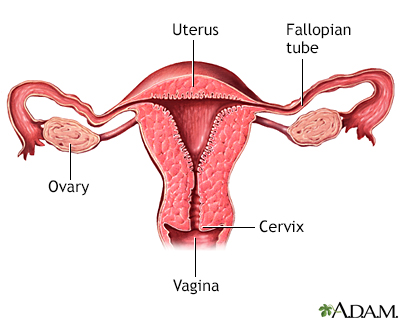Pregnancy SmartSiteTM
Trichomonas vaginitis; STD - trichomonas vaginitis; STI - trichomonas vaginitis; Sexually transmitted infection - trichomonas vaginitis; Cervicitis - trichomonas vaginitis DefinitionTrichomoniasis is a sexually transmitted infection caused by the parasite Trichomonas vaginalis. CausesTrichomoniasis (trich) is found worldwide. In the United States, most cases occur in women between ages 16 and 35 years. Trichomonas vaginalis is spread through sexual contact with an infected partner, either through penis-to-vagina intercourse or vulva-to-vulva contact. The parasite cannot survive in the mouth or rectum. The disease can affect both men and women, but the symptoms differ. The infection usually does not cause symptoms in men and goes away on its own in a few weeks. SymptomsWomen may have these symptoms:
Men who have symptoms may have:
Occasionally, some men with trichomoniasis may develop:
Exams and TestsIn women, a pelvic examination shows red blotches on the vaginal wall or cervix. Examining the vaginal discharge under a microscope may show signs of inflammation or infection-causing germs in vaginal fluids. A Pap test may also diagnose the condition, but is not required for diagnosis. The disease can be hard to diagnose in men. Men are treated if the infection is diagnosed in any of their sexual partners. They may also be treated if they keep having symptoms of urethral burning or itching, even after getting treatment for gonorrhea and chlamydia. TreatmentAntibiotics, most often metronidazole (Flagyl) or tinidazole (Tindamax), are commonly used to cure the infection. Do not drink alcohol while taking the medicine and for 48 hours afterward. Doing so can cause:
Avoid sexual intercourse until you have finished treatment. Your sexual partners should be treated at the same time, even if they have no symptoms. If you have been diagnosed with a sexually transmitted infection (STI), you should be screened for other STIs. Outlook (Prognosis)With proper treatment, you are likely to fully recover. Possible ComplicationsLong-term infection may cause changes in the tissue on the cervix. These changes may be seen on a routine Pap smear. Treatment should be started and the Pap test should be repeated 3 to 6 months later. Treating trichomoniasis helps prevent it from spreading to sexual partners. Trichomoniasis is more common among people with HIV/AIDS. This condition has been linked to premature delivery in pregnant women. More research about trichomoniasis in pregnancy is still needed. When to Contact a Medical ProfessionalContact your health care provider if you have any unusual vaginal discharge or irritation. Also, call if you suspect that you have been exposed to the disease. PreventionPracticing safer sex can help reduce the risk of sexually transmitted infections, including trichomoniasis. Other than total abstinence, condoms remain the best and most reliable protection against sexually transmitted infections. Condoms must be used consistently and correctly to be effective. ReferencesAbdallah M, Augenbraun MH, McCormack W. Vulvovaginitis and cervicitis. In: Bennett JE, Dolin R, Blaser MJ, eds. Mandell, Douglas, and Bennett's Principles and Practice of Infectious Diseases. 9th ed. Philadelphia, PA: Elsevier; 2020:chap 108. Centers for Disease Control and Prevention website. Trichomoniasis. About trichomoniasis. www.cdc.gov/trichomoniasis/about/. Updated December 13, 2023. Accessed November 27, 2024. Telford SR, Krause PJ. Babesiosis and other protozoan diseases. In: Goldman L, Cooney KA, eds. Goldman-Cecil Medicine. 27th ed. Philadelphia, PA: Elsevier; 2024:chap 324. | ||
| ||
Review Date: 11/10/2024 Reviewed By: Jatin M. Vyas, MD, PhD, Roy and Diana Vagelos Professor in Medicine, Columbia University Vagelos College of Physicians and Surgeons, Division of Infectious Diseases, Department of Medicine, New York, NY. Also reviewed by David C. Dugdale, MD, Medical Director, Brenda Conaway, Editorial Director, and the A.D.A.M. Editorial team. View References The information provided herein should not be used during any medical emergency or for the diagnosis or treatment of any medical condition. A licensed medical professional should be consulted for diagnosis and treatment of any and all medical conditions. Links to other sites are provided for information only -- they do not constitute endorsements of those other sites. No warranty of any kind, either expressed or implied, is made as to the accuracy, reliability, timeliness, or correctness of any translations made by a third-party service of the information provided herein into any other language. © 1997- A.D.A.M., a business unit of Ebix, Inc. Any duplication or distribution of the information contained herein is strictly prohibited. | ||


 Normal uterine ana...
Normal uterine ana...
